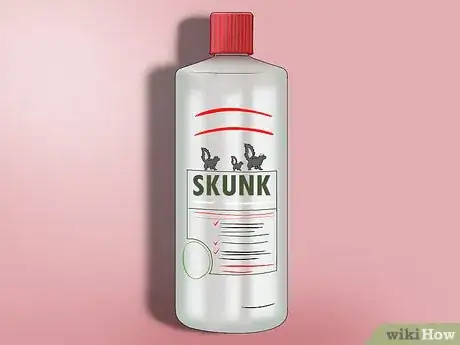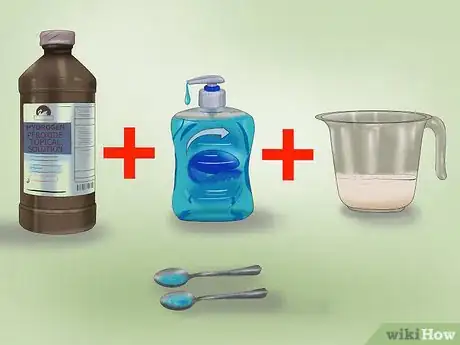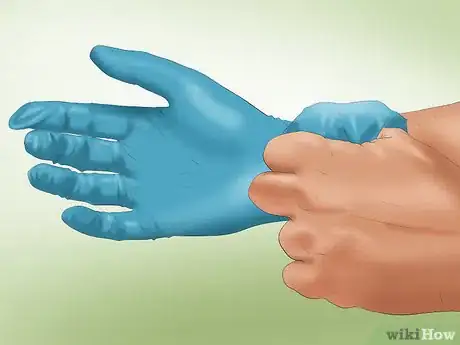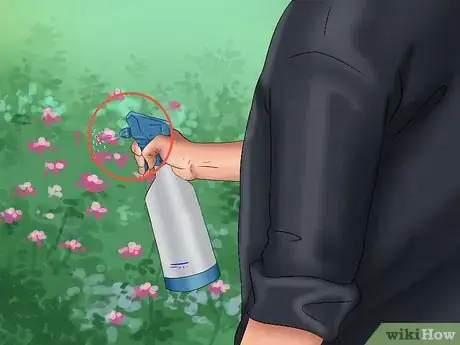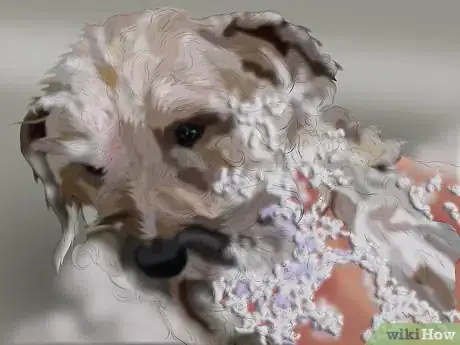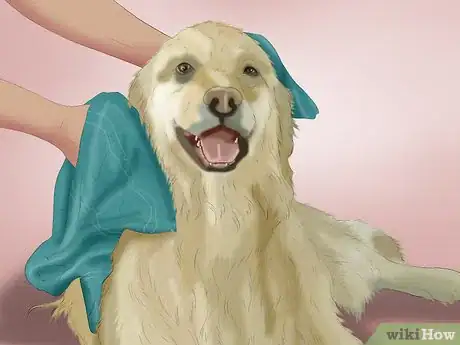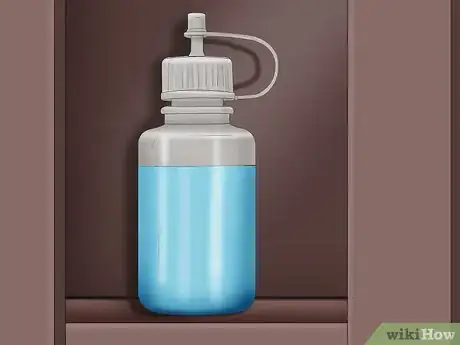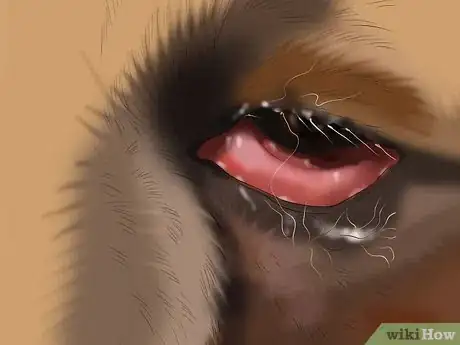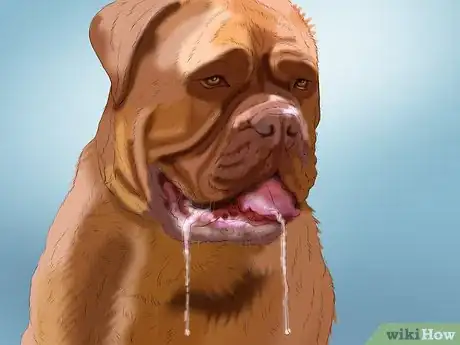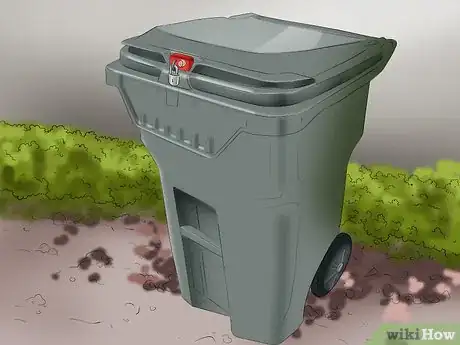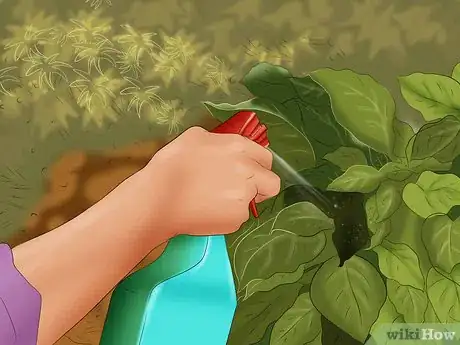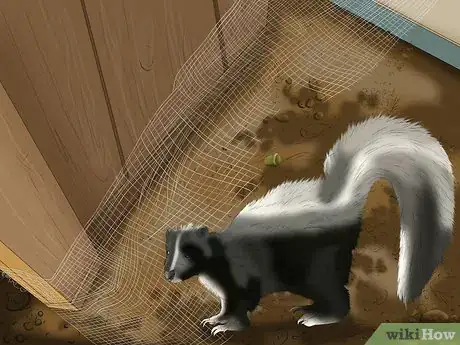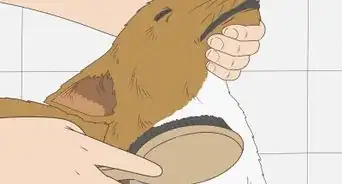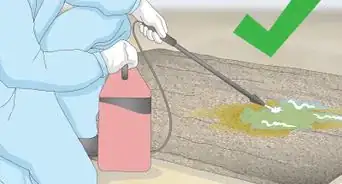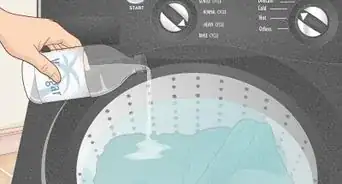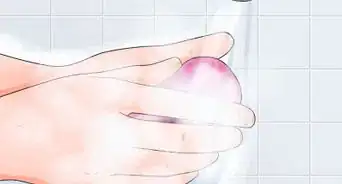This article was co-authored by Natalie Punt, DVM. Dr. Natalie Punt is a Veterinarian and the Founder and CEO of mPet- a smart phone app for pet owners to store, manage and transfer their pets medical records and health information. She specializes in small animal emergency and general medicine and veterinary practice economics. Dr. Punt holds a BS in Biochemistry and Molecular Biology from The University of California, Davis, an MS in Biochemistry from The University at Buffalo, and a DVM from Western University of Health Sciences.
wikiHow marks an article as reader-approved once it receives enough positive feedback. In this case, several readers have written to tell us that this article was helpful to them, earning it our reader-approved status.
This article has been viewed 356,103 times.
Few things are as aromatically repugnant as a dog sprayed by a skunk. That smelly odor has a bad habit of lingering and spreading as well. Usually, the smell is the biggest problem. However, skunk spray can occasionally cause some minor (or even serious) health issues in the sprayed dog. You can help avoid all of this by knowing how to care for a skunk-sprayed dog.
Steps
Treating a Skunk-Sprayed Dog
-
1Understand the chemistry. The smelly part of the skunk spray is from chemicals called thiols.[1] These awful-smelling oils make the scent “stick” to the sprayed dog. Unfortunately, you cannot simply shampoo and rinse these oils away.
- Also, skip the tomato juice myth because that will not eliminate the oils either.
-
2Mix a homemade solution to remove the oils. There are special chemical solutions used to remove substances containing thiols. You can mix a mild form of this solution at home that is safe for your dog. The following formula will make enough to scrub a small- or medium-sized dog. Double or even triple the amounts for very large dogs. You should mix:[2]
- 1 quart 3% hydrogen peroxide
- 1/4 cup baking soda
- 1 teaspoon liquid hand soap
Advertisement -
3Wear gloves. The solution has the potential to irritate your skin, so you should wear gloves when you mix and use it. You also want to wear gloves to avoid transferring any of the skunk smell to yourself while handling the stinky dog.
- The solution may irritate your dog’s skin as well, especially if the pet is prone to skin infections or other skin conditions. In these cases, consult your veterinarian before using the solution.
-
4Apply the solution outside. In addition to keeping the smelly dog from spreading the smell inside, you want to use the solution outside because the peroxide can potentially stain wood, cloth furniture, and other household items.
-
5Scrub the dog with the solution. Gently scrub the dog with the solution, but be careful to avoid the eyes and inner ears. Allow the solution to sit for up to five minutes but no more than that. Rinse the dog very thoroughly since the peroxide can discolor fur.
- If the smell remains, you may have to repeat the process.
-
6Dry your dog well. Make sure you dry the dog well before allowing him back in the house. You should also keep an eye on him during this period and watch for other complications from being sprayed.
- If your dog gets wet at all within a week or so, you may faintly notice the skunk smell again. Try not to bathe your dog again for a week.
-
7Do not store the solution. The solution will lose its effectiveness from sitting, so you should make and use it immediately. Do not store the solution for future use if you make too much.
-
8Use a skunk-removal spray or shampoo.[3] There are also shampoos formulated for removing skunk spray from a dog’s coat. However, they’re more expensive than the ingredients for the homemade solution, and they likely will not work as well. Your veterinarian may suggest one of these shampoos instead of the solution if your dog is prone to skin conditions that make the homemade solution inadvisable.
Watching Your Dog for Possible Complications
-
1Watch for eye irritation.[4] The spray can cause extreme irritation if it hits the eyes directly. If your dog shows signs of eye irritation—frequently pawing at the eyes, reddened and tearing eyes, eye swelling, squinting, or hard-to-open eyes—try to rinse your dog’s eyes carefully with plain tap water. You should also immediately contact a veterinarian.
-
2Pay attention for respiratory irritation. Dogs can also inhale the spray, leading to irritation to the respiratory system, including the nose. This may cause sneezing, nasal discharge, or drooling. Contact a veterinarian immediately if you notice these symptoms after a skunk encounter.
-
3Follow up with a rabies vaccine booster. While the spray of skunks does not carry the rabies virus, skunks are big carriers of rabies. Any time a dog encounters a skunk, there is a chance of exposure to the virus. Consult with your veterinarian after your dog has been sprayed to discuss a rabies vaccine booster to keep your pet safe.
-
4Watch for lethargy, weakness, or loss of appetite. A very rare but serious condition called Heinz body hemolytic anemia can occur in a dog sprayed by a skunk.[5] This is an emergency. A veterinarian must treat the dog for this potentially life-threatening condition. Signs of the anemia include pale mucous membranes, rapid heartbeat, panting, or a weak pulse.
- In a more gradual onset, the dog may be lethargic, weak, and refuse to eat. Signs can occur up to a few days after the dog has been sprayed by the skunk.
Reducing the Chances of Skunk Encounters
-
1Keep a close eye on your dog. If you have a very large, open backyard, consider fencing in a portion to keep your dog out of trouble and away from skunks.
-
2Use tightly fitting lids on trashcans. Skunks seek human garbage, so use garbage cans with tightly fitting lids. This helps prevent the odors from tempting skunks and other animals.
-
3Purchase chemical skunk deterrents. You can buy special deterrents online or at garden supply stores to protect your yard from skunk invasion.
-
4Cover any openings around your home. Skunks may try to live under decks or other structures around your home. To prevent this, seal any openings large enough for a skunk.
-
5Contact a local animal control officer. If you know you have a skunk problem around your yard or neighborhood, contact your local animal control. Depending on where you live, they may set traps or offer to come deal with the animals if you set your own traps.
Expert Q&A
-
QuestionWhat is the best remedy for a dog that got sprayed by a skunk?
 Natalie Punt, DVMDr. Natalie Punt is a Veterinarian and the Founder and CEO of mPet- a smart phone app for pet owners to store, manage and transfer their pets medical records and health information. She specializes in small animal emergency and general medicine and veterinary practice economics. Dr. Punt holds a BS in Biochemistry and Molecular Biology from The University of California, Davis, an MS in Biochemistry from The University at Buffalo, and a DVM from Western University of Health Sciences.
Natalie Punt, DVMDr. Natalie Punt is a Veterinarian and the Founder and CEO of mPet- a smart phone app for pet owners to store, manage and transfer their pets medical records and health information. She specializes in small animal emergency and general medicine and veterinary practice economics. Dr. Punt holds a BS in Biochemistry and Molecular Biology from The University of California, Davis, an MS in Biochemistry from The University at Buffalo, and a DVM from Western University of Health Sciences.
Veterinarian Baking soda could be worth a try. Skunk spray has a really strong sulfur component to it, and the baking soda may help neutralize it.
Baking soda could be worth a try. Skunk spray has a really strong sulfur component to it, and the baking soda may help neutralize it. -
QuestionWhat do you do if a skunk sprays your dog in the face?
 Natalie Punt, DVMDr. Natalie Punt is a Veterinarian and the Founder and CEO of mPet- a smart phone app for pet owners to store, manage and transfer their pets medical records and health information. She specializes in small animal emergency and general medicine and veterinary practice economics. Dr. Punt holds a BS in Biochemistry and Molecular Biology from The University of California, Davis, an MS in Biochemistry from The University at Buffalo, and a DVM from Western University of Health Sciences.
Natalie Punt, DVMDr. Natalie Punt is a Veterinarian and the Founder and CEO of mPet- a smart phone app for pet owners to store, manage and transfer their pets medical records and health information. She specializes in small animal emergency and general medicine and veterinary practice economics. Dr. Punt holds a BS in Biochemistry and Molecular Biology from The University of California, Davis, an MS in Biochemistry from The University at Buffalo, and a DVM from Western University of Health Sciences.
Veterinarian Try flushing out the skunk spray with some gentle tears or some regular eye drops.
Try flushing out the skunk spray with some gentle tears or some regular eye drops. -
QuestionHow do you get rid of the skunk smell out of your home?
 Pippa Elliott, MRCVSDr. Elliott, BVMS, MRCVS is a veterinarian with over 30 years of experience in veterinary surgery and companion animal practice. She graduated from the University of Glasgow in 1987 with a degree in veterinary medicine and surgery. She has worked at the same animal clinic in her hometown for over 20 years.
Pippa Elliott, MRCVSDr. Elliott, BVMS, MRCVS is a veterinarian with over 30 years of experience in veterinary surgery and companion animal practice. She graduated from the University of Glasgow in 1987 with a degree in veterinary medicine and surgery. She has worked at the same animal clinic in her hometown for over 20 years.
Veterinarian Many of the solutions used for bathing your dog can be used in the home. Just be sure to test any fabrics or carpet for color fastedness first. In addition a steam cleaner or carpet cleaner can be an invaluable asset, and repeat clean the area daily until the smell has gone.
Many of the solutions used for bathing your dog can be used in the home. Just be sure to test any fabrics or carpet for color fastedness first. In addition a steam cleaner or carpet cleaner can be an invaluable asset, and repeat clean the area daily until the smell has gone.
References
- ↑ New Components in Defensive Secretion of the Striped Skunk, Mephitis mephitis." William F. Wood, J. Chemical Ecology 16, 2057-2065 (1990)
- ↑ Chem. Eng. News, 1993, 71 (42), p 90
- ↑ Natalie Punt, DVM. Veterinarian. Expert Interview. 19 August 2021.
- ↑ Natalie Punt, DVM. Veterinarian. Expert Interview. 19 August 2021.
- ↑ Zaks KL, Tan EO, Thrall MA. Heinz body anemia in a dog that had been sprayed with skunk musk. J Am Vet Med Assoc 2005;226(9):1516-1518, 1500
- ↑ Natalie Punt, DVM. Veterinarian. Expert Interview. 19 August 2021.
About This Article
To care for a skunk-sprayed dog, start by mixing 1 quart of 3 percent hydrogen peroxide, 1/4 cup of baking soda, and 1 teaspoon of hand soap. After putting on rubber gloves to protect your hands, take your dog outside and gently scrub the mixture into its fur, making sure to avoid its eyes and inner ears. Then, allow the soap to sit for up to 5 minutes before rinsing it out thoroughly. Finally, dry your dog well before you allow it back in the house. For advice from our Veterinary co-author on how to help your dog if its eyes are irritated by the skunk spray, read on!
